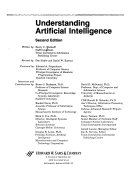
Understanding Artificial Intelligence
Dan Shafer, Henry C. Mishkoff 20 min

Artificial Intelligence (AI) is a branch of computer science that aims to create machines capable of performing tasks that would typically require human intelligence. This includes problem-solving, understanding natural language, recognizing patterns, and learning from experience. The book delves into the various subfields of AI, including machine learning, natural language processing, robotics, and computer vision. By defining AI and its scope, the author sets a foundation for understanding its potential applications and implications in various sectors, from healthcare to finance. The exploration of these subfields highlights how interconnected and interdisciplinary AI is, as it draws on concepts from mathematics, psychology, neuroscience, and engineering. Furthermore, the book discusses the importance of understanding the limitations of AI, as it is not a panacea for all problems but a tool that needs to be applied thoughtfully and ethically.
Continue readingThe book traces the historical development of AI, starting from early concepts in the 1950s to the current state of the technology. It discusses key milestones, such as the invention of neural networks, the advent of deep learning, and the breakthroughs in natural language processing that have transformed how machines understand human communication. By providing a timeline of AI's evolution, the author emphasizes the rapid pace of innovation and the cumulative nature of technological advancements. The narrative also covers the role of significant figures in AI's history, the challenges they faced, and how their contributions shaped the field. Understanding this evolution is crucial for grasping the current capabilities of AI and anticipating future trends and challenges.
Continue readingAI is transforming various industries by enhancing efficiency, accuracy, and decision-making processes. The book explores diverse applications, such as AI in healthcare for diagnostics and personalized medicine, in finance for fraud detection and algorithmic trading, and in manufacturing for predictive maintenance and automation. Each application is examined in terms of its impact on productivity and the potential to disrupt traditional practices. The author illustrates how businesses leverage AI to gain competitive advantages and improve customer experiences. Moreover, the discussion includes ethical considerations surrounding these applications, such as privacy concerns and the potential for bias in AI algorithms, urging readers to think critically about the implications of AI deployment.
Continue readingAs AI technologies become more integrated into daily life, ethical considerations become paramount. The book addresses the moral dilemmas associated with AI, such as data privacy, accountability, and the potential for job displacement. The author emphasizes the importance of developing ethical frameworks to guide AI development and deployment, advocating for transparency and fairness in AI systems. By presenting real-world case studies where ethical lapses have occurred, the book encourages readers to consider the societal impact of AI and the responsibility of developers and organizations to mitigate risks. This discussion is vital for fostering a culture of ethical AI that prioritizes human well-being and societal benefit.
Continue readingThe book speculates on the future trajectory of AI, considering advancements in technology and their potential societal implications. The author discusses the concept of superintelligence and the hypothetical scenarios surrounding it, including both optimistic and pessimistic views on how AI could reshape humanity. The narrative also addresses the importance of interdisciplinary collaboration in AI research and the need for inclusive dialogue among technologists, policymakers, and the public. By exploring potential future scenarios, the book encourages readers to think critically about the role of AI in society and the proactive steps needed to ensure that its development aligns with human values and needs.
Continue readingThe integration of AI into the workforce presents both opportunities and challenges. The book analyzes how AI can augment human labor, increase productivity, and create new job categories while also addressing the fear of job displacement. The author emphasizes the need for workforce reskilling and upskilling to prepare for an AI-driven economy. By providing insights into how organizations can adapt and thrive amidst technological change, the book serves as a guide for employees and employers alike. It also discusses the role of education in fostering a workforce that is adaptable and equipped to work alongside AI technologies.
Continue readingTo effectively engage with AI, individuals must cultivate a specific set of skills and knowledge. The book outlines the essential competencies needed to navigate the AI landscape, including data literacy, programming skills, and an understanding of machine learning principles. It also highlights the importance of soft skills, such as critical thinking and creativity, in complementing technical abilities. By providing practical advice on how to acquire these skills, the author empowers readers to take charge of their learning and career development in an increasingly AI-centric world. This emphasis on skill development is crucial for anyone looking to remain relevant in the evolving job market.
Continue readingThe reading time for Understanding Artificial Intelligence depends on the reader's pace. However, this concise book summary covers the 7 key ideas from Understanding Artificial Intelligence, allowing you to quickly understand the main concepts, insights, and practical applications in around 20 minutes.
Understanding Artificial Intelligence is definitely worth reading. The book covers essential topics including The Definition and Scope of AI, The Evolution of AI Technologies, Applications of AI Across Industries, providing practical insights and actionable advice. Whether you read the full book or our concise summary, Understanding Artificial Intelligence delivers valuable knowledge that can help you improve your understanding and apply these concepts in your personal or professional life.
Understanding Artificial Intelligence was written by Dan Shafer, Henry C. Mishkoff.
If you enjoyed Understanding Artificial Intelligence by Dan Shafer, Henry C. Mishkoff and want to explore similar topics or deepen your understanding, we highly recommend these related book summaries:
These books cover related themes, complementary concepts, and will help you build upon the knowledge gained from Understanding Artificial Intelligence. Each of these summaries provides concise insights that can further enhance your understanding and practical application of the ideas presented in Understanding Artificial Intelligence.